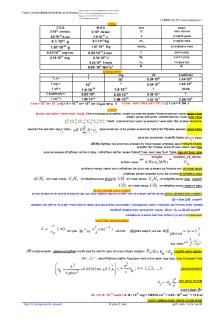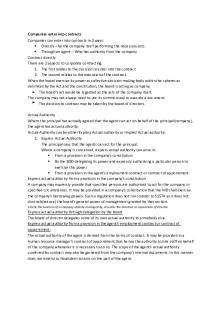Chem 30 Formulas - 123 PDF

| Title | Chem 30 Formulas - 123 |
|---|---|
| Author | Shae Antonides |
| Course | General Biology I |
| Institution | The University of Western Ontario |
| Pages | 3 |
| File Size | 107.7 KB |
| File Type | |
| Total Downloads | 32 |
| Total Views | 130 |
Summary
123...
Description
Chemistry 30 – Formulas and Information Thermochemistry: Formula: Q = mc∆t nH = mc∆t
∆H = ∑nfH(products) - ∑nfH(reactants) % efficiency = energy output x 100 energy input
Variables:
When to use:
Q = total heat/enthalpy (J or kJ) m = mass (g) c = specific heat capacity (J/g◦C or kJ/g◦C) ∆t = temperature change (◦C) n = moles of substance reacting (n = cv or m/M) (mol) H = molar heat/ enthalpy of substance reacting (J/mol or kJ/mol) m = mass of water (1g = 1 mL) c = specific heat capacity of water (J/g◦C or kJ/g◦C) ∆t = temp. change of water (◦C) ∆H = total heat/ enthalpy (J or kJ) ∑nfH (products) = sum of heats of formations of products ∑nfH (reactants) = sum of heats of formations of reactants
If given the specific heat capacity, mass and temperature change of one substance.
% efficiency (%) energy output (J or kJ released by a system) energy input (J or kJ absorbed by a system)
Calorimetry questions: - if given information about a reacting substance and water (remember water is present to determine the energy released or absorbed by the reaction) - usually asked to find the molar enthalpy (H) Hess’s Law: - if only have a reaction with no other energy information - remember: - use data booklet for heats of formations of several compounds - elements have a heat of formation of zero If asked for % efficiency and given the energy released and used by a system
Electrochemistry: Formula: Variables: ◦ ◦ ◦ E = net voltage of a cell (V) E net = E red + E ox E = voltage of the reduction half reaction (V) ◦ net ◦ red ◦ ox
E
q = It ne = q or It F F
= voltage of the oxidation half reaction (V)
q = charge (C) I = current (C/s or I) t = time (s) ne= moles of electrons (mol) q = charge (C) I = current (C/s or I) t = time (s) F = 9.65 x 104 C/mol (Faraday’s Constant) n = moles of reacting substance (mol)
When to use: If asked to find the voltage of a cell: - the voltages come from the data booklet - the oxidation half reaction comes from flipping the reduction half reaction in the data booklet (remember to flip the voltage sign as well, but you don’t need to multiply the voltage if reaction was multiplied for equal electron transfers) Electrical Stoichiometry: - if given info about an electrolytic process such as running a current and the length of time Electrical Stoichiometry: - if given info about an electrolytic process such as running a current and the length of time used to produce a solid metal - need to write the half reaction of the metal (substance) being electroplated or refined - use the ne to calculate the n of the reacting substance (multiply n by the coefficient ratios wanted/ given)
n = m or Cv M n = m or Cv M
m = mass of reacting substance (g) M = molar mass of reacting substance (g/mol) c = concentration of reacting solution (mol/L) v = volume of reacting solution (L)
- use other common chemistry formulas to convert moles back into mass, concentration or volume
n = moles of reacting substance (mol) m = mass of reacting substance (g) M = molar mass of reacting substance (g/mol) c = concentration of reacting solution (mol/L) v = volume of reacting solution (L)
Redox Titrations: - need to write the net reaction between the SOA and SRA - use the ng (of the given substance) to calculate the nw (of the wanted substance) by multiply ng by the coefficient ratios wanted/ given - use other common chemistry formulas to convert moles back into mass, concentration or volume
Equilibrium of Acids & Bases Unit: Formula: +
pH = -log [H30 ] [H30+] = [SA] or √(Ka [WA]) Ka = [H30+]2 [acid] pOH = -log [OH-] [OH-] = x [SB] or √(Kb [WB]) Kb = [OH-]2 or Kw [base] Ka pH = 14 – pOH [H30+] = 10-pH [OH-] = 10-pOH % ionization = [H30+] x 100 [acid]
Variables: pH = uses decimal places as SD (no units) [H30+] = concentration of H+ [SA] = concentration of strong acid (mol/L) [WA] = concentration of weak acid (mol/L) Ka = ionization constant of an acid (no units) (in data booklet)
When to use: Deals with acids (identified by having H+ ions) SA = strong acids (top 6 in data booklet table) and Ka >1 WA = all other acids (Ka...
Similar Free PDFs

Chem 30 Formulas - 123
- 3 Pages

SSC Gen Chem II Formulas
- 1 Pages

Chem 30 Tables and Values
- 6 Pages

123
- 8 Pages

Tumws 20VDA-Formulas - Formulas
- 5 Pages

Formulas
- 2 Pages

125001-Formulas - formulas sheet
- 8 Pages

Formulas
- 6 Pages

Formulas
- 1 Pages

Formulas
- 2 Pages

Lenovo - 123
- 43 Pages

Cantera - 123
- 27 Pages

Authority - 123
- 3 Pages

Liesmich - 123
- 46 Pages
Popular Institutions
- Tinajero National High School - Annex
- Politeknik Caltex Riau
- Yokohama City University
- SGT University
- University of Al-Qadisiyah
- Divine Word College of Vigan
- Techniek College Rotterdam
- Universidade de Santiago
- Universiti Teknologi MARA Cawangan Johor Kampus Pasir Gudang
- Poltekkes Kemenkes Yogyakarta
- Baguio City National High School
- Colegio san marcos
- preparatoria uno
- Centro de Bachillerato Tecnológico Industrial y de Servicios No. 107
- Dalian Maritime University
- Quang Trung Secondary School
- Colegio Tecnológico en Informática
- Corporación Regional de Educación Superior
- Grupo CEDVA
- Dar Al Uloom University
- Centro de Estudios Preuniversitarios de la Universidad Nacional de Ingeniería
- 上智大学
- Aakash International School, Nuna Majara
- San Felipe Neri Catholic School
- Kang Chiao International School - New Taipei City
- Misamis Occidental National High School
- Institución Educativa Escuela Normal Juan Ladrilleros
- Kolehiyo ng Pantukan
- Batanes State College
- Instituto Continental
- Sekolah Menengah Kejuruan Kesehatan Kaltara (Tarakan)
- Colegio de La Inmaculada Concepcion - Cebu

